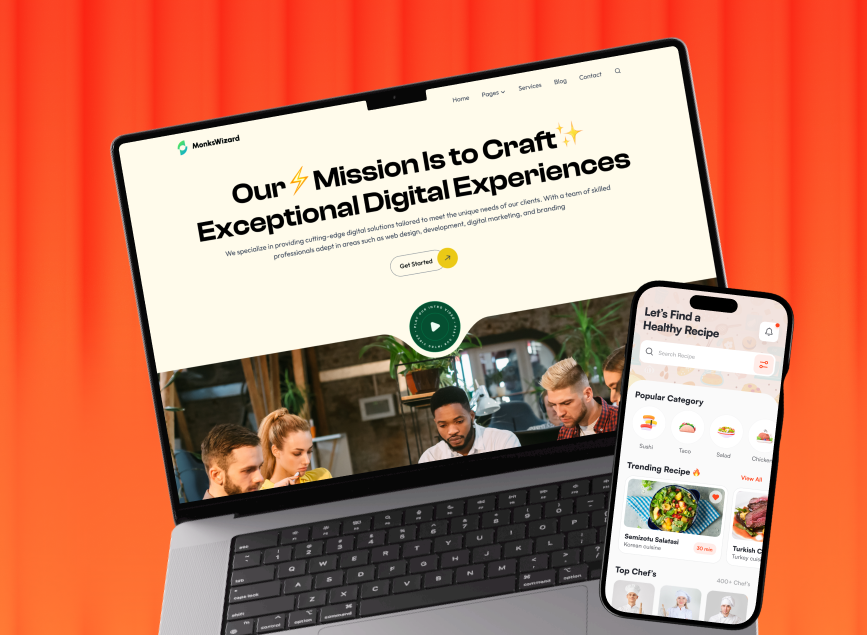
Key Takeaways
- Interaction design focuses on intuitive, engaging, and user-friendly digital experiences.
- Principles like consistency, minimalism, and accessibility guide effective product design.
- Designs must enhance engagement through feedback, gamification, and exploration features.
- Error handling and user onboarding improve usability and satisfaction significantly.
- Affordable, user-centered interaction design ensures accessibility and long-term adoption.
Interaction design refers to the type that solely focuses on designing products or services that enhance user interactions. There are some principles of this interaction design that are particularly the cornerstone of user-centric digital experiences.
These principles help shape how individuals engage with interfaces on different devices and platforms. They are like the frameworks that provide designers with a roadmap for creating intuitive, efficient, and meaningful interactions.
Generally, interaction design principles associate factors like consistency, feedback, accessibility, and minimalism. The aim is to optimize usability, enhance engagement, and facilitate seamless navigation.
Well, no matter if you are a beginner or a professional designer, you should be aware of these principles and keep them in mind whenever working on a project. In this discussion, we'll talk about all these principles to make you enlightened of these matters of the first magnitude.
What Is Interaction Design?
Interaction design is shortly known as ID. It's basically a field of design that focuses on creating products, systems, or services that improve user interactions in the most effective way possible. The aim here is to make every interaction intuitive, engaging, and ultimately, user-friendly.
Designers in this field simply make UI elements much more navigational, and micro-interactional so that they can guide users through actions. The main goal of interaction design is to humanize how we engage with digital products. For that, it requires empathy and connection with users.
Additionally, interaction design aims to predict user behavior. Later, it utilizes insights from user research and works accordingly to enhance usability and create experiences that meet user needs.
Interaction Design Principles Every Designer Should Learn
Certainly, there is no established set of principles for interaction design. It’s because design experts come with different sets based on their prospects. In that sense, there can be tons of principles you can follow.
However, following and maintaining all the principles is not possible, and at the same time, they may not be trustworthy. Here, we have described 10 principles of interaction design that you can trust as they all are logically accepted.

The Design Must Meet User Experience and Need
In the world of interaction design, user-centric design should get the utmost priority. While making a design, they should consider the user experience along with understanding the needs, preferences, and pain points of the target audience.
Designers should conduct user research, like interviews, surveys, and usability testing. It is essential to gain valuable insights into user behaviors and expectations.
Also, they should remember that design decisions should be driven by empathy and a deep understanding of the users' goals and challenges. Their goal should be to ensure that the product or interface meets the user's needs effectively.
Functionally, It will be Minimal
Minimalism is another must-have for a successful design. Designers should follow the rules of minimalism in design and specifically focus on stripping away unnecessary elements and features to create a streamlined and efficient user experience.

A minimalistic approach prioritizes clarity, simplicity, and usability. It must avoid clutter and complexity that can overwhelm users. By distilling the interface down to its essential components, designers can enhance the usability of a project. This approach can dramatically reduce cognitive load, and facilitate intuitive interactions.
It Should be Consistent All Over the Project
The next thing is being Consistent. To create a cohesive and intuitive user experience, you must be consistent throughout the project. You should showcase the practice of consistency in choosing and using design elements, like layout, typography, color schemes, and terminology.
It will help users navigate the interface confidently and predictably. You can also establish properly consistent design patterns and standards to use throughout the project. This practice will simply reinforce familiarity, reduce confusion, and enhance overall usability.
Must be Easy to Understand for All User Types
What's the point of designing a project that users won't find easy to understand? No, this type of complicated design can never bring any good for the product.
Designers should always work to bring accessibility and inclusivity to ensure that users of all abilities and backgrounds can engage with the interface effectively.
For that, you should prioritize clear and intuitive design that comes with thoughtful information architecture and navigation. The design must be suitable for users of different levels of digital literacy and cognitive abilities.
At the same time, as a designer, you should prioritize readability, simplicity, and clarity. Your aim should be to ensure that the interface is easily understandable and navigable for everyone.
Should Have Abilities to Improve User Engagement
A digital design that can't improve user engagement is not something helpful. Engaging users is essential to enhance user interest, motivation, and loyalty. For that, the designer should use interactive elements, gamification techniques, and feedback mechanisms.

These elements can enhance user engagement and encourage continued interaction with the interface. They also offer users opportunities for exploration, personalization, and social interaction.
Following these Interaction Design Principles, you can create immersive and rewarding user experiences that will bring back the audience to your website again and again.
Should Have User Interaction Teaching Session
A big part of the entire audience of a digital product must have limitations in technical ideas. That's why you should let them know how to use your product. You should provide users with the knowledge and skills to interact effectively with the interface.

It is very essential to ensure usability and satisfaction. You should also provide onboarding tutorials, tooltips, guided tours, and interactive walkthroughs. These aspects can orient users to the interface and teach them how to navigate its features and functionalities.
So, to make them feel comfortable while using the product, you should create a smooth and intuitive learning session that will minimize frustration and support users in achieving their goals.
Must-Have Ability to Troubleshoot Potential Errors
After even properly completing designing a product, errors, and bugs can appear at any time. Even when you deliver it to the clients and they use it, these errors and bugs can pop up.
That's why you need to make sure that your design is powerful enough to detect those errors so that the management team can fix them. However, error handling is an integral aspect of usability design. It apparently helps users recover from mistakes and navigate obstacles effectively.
In this case, you need to design and employ clear and informative error messages, provide helpful prompts and suggestions, and implement intuitive error recovery mechanisms.
These implementations can dramatically mitigate user frustration and at the same time, enhance confidence in the interface. Additionally, while conducting user research, you should anticipate and address potential errors proactively. This is also an effective way to minimize user friction and maintain a positive user experience.
Must Encourage Users to Explore More
An ideal digital product design must create curiosity among the audience so that they want to explore it more. The approach of encouraging exploration and discovery comes from users' curiosity and ends with making scope for later engagement.
To make the product more attractive, as a designer, you should design for serendipity, provide recommendations, and surface relevant content or features based on user behavior.
These aspects can significantly encourage users to explore beyond their immediate needs. This way, they can discover new functionalities or opportunities. So, designers should design a product in a way that increases a sense of exploration and discovery to enrich the user experience and create lasting engagement.
Utilize Interactive Media to Improve Interaction
While designing a product, you need to utilize interactive media, like animations, videos, and interactive widgets. These approaches can enhance user engagement and comprehension.

Dynamic visual feedback, immersive storytelling, and interactive demonstrations can significantly grab users' attention, communicate complex concepts effectively, and guide them through interactive experiences seamlessly.
When you incorporate interactive media thoughtfully and purposefully, it'll dramatically enhance user experience. This Interaction Design Principle will also create memorable interactions that resonate with users.
Must be Affordable
Finally, it's about affordability. Your interaction design should be affordable enough so that clients can find it worthy of the money they offer. Affordability is a must-have consideration in the design, particularly for products and services intended for widespread adoption.
Generally, design decisions should balance functionality, usability, and cost-effectiveness to ensure that the solution remains accessible and sustainable for the target audience.
For that, you can optimize resource allocation, prioritize essential features, and get help from cost-effective technologies and design solutions. These tricks can help you create high-quality experiences that meet user needs without exceeding budget constraints.
However, if you are not so convinced that following these principles is easy, leave it and contact the Design Monk. This company offers UI and UX support at an affordable cost but with exceptional outcomes.

FAQs
How can interaction design improve user engagement?
Interaction design can improve user engagement by implementing interactive elements, feedback mechanisms, and personalized experiences. This type of design provides opportunities for exploration, customization, and social interaction.
Why is minimalism important in interaction design?
Minimalism is important in interaction design because it focuses on simplicity and clarity. This approach removes unnecessary elements and streamlines the user experience. It also reduces cognitive load, enhances comprehension, and promotes intuitive interaction.
How can interaction design principles be tested and validated?
Interaction design principles can be tested through usability testing, user feedback sessions, and analytics tracking. These methods help identify usability issues, validate design decisions, and ensure that the interface aligns with users' needs and expectations.
Wrap Up
Hopefully, you’ve got a proper idea of the interaction design principles. Maintaining all these principles is essential not just for designing a project perfectly but for its success in the long run.
Also, it’s essential to prioritize all the principles to improve a project’s usability, engagement, and accessibility for diverse user groups. Also, designers should incorporate familiar conventions, testing methodologies, and progressive disclosure techniques to make sure that interfaces are intuitive, learnable, and adaptable to user needs.
For positive user interactions, empowering individuals of all abilities, and contributing to the development of inclusive, accessible, and impactful digital products, designers should have a clear idea of how to implement these principles.

.svg)






.png)
.png)
.png)
.png)


.png)
.png)
.png)
.png)



.avif)



